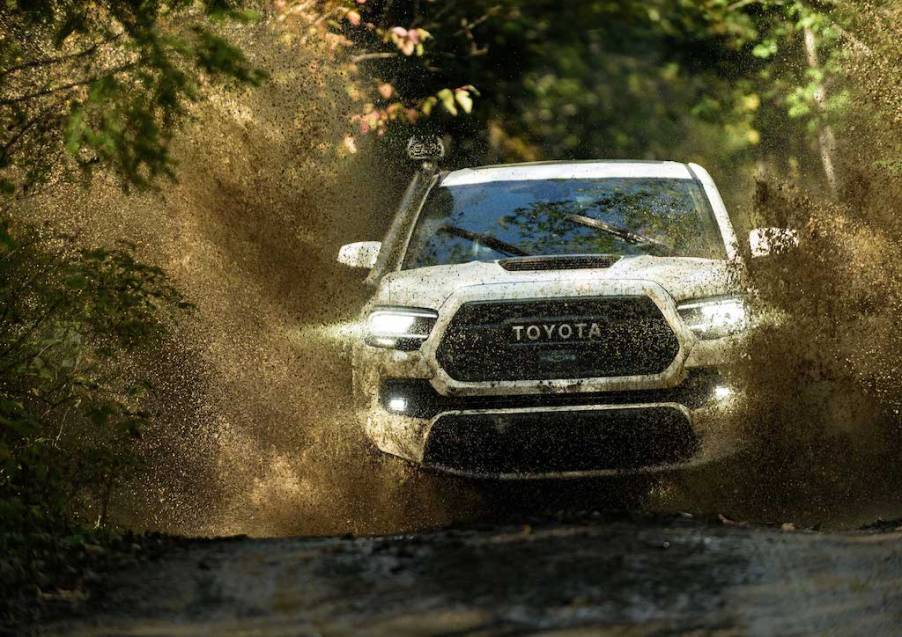
Watch How Well the Toyota Tacoma TRD Pro Handles Deep Mud
The folks at the YouTube channel TFLoffroad recently took the 2019 Toyota Tacoma TRD Pro out for a test drive. While they didn’t have any way to test the desert air intake feature that the TRD offers, one thing they did have? Plenty of mud and water.
Stephen Elmer for the TFLoffroad channel decided to use their hydro line trail to test the tires, rear differential lock, and crawl control of the TRD. He then engaged in some high-speed off-roading to test the Tacoma TRD’s suspension.
The 2019 Toyota Tacoma TRD
Stephen explained that while the powertrain for the Tacoma TRD didn’t change in 2019, the way it delivered power was slightly modified. Under the hood, it has a 3.5-liter V6 engine with an output of 278 horsepower and 265 lb-ft. of torque.
Following some comments from consumers, 2019’s TRD Pro strived for a broader power band across the revs to make it more responsive. Considering it reached peak horsepower at 6000 rpm and peak torque at 4600 rpm, they wanted a punchier performance in the low end.
Toyota used Goodyear Wranglers with Kevlar protection on the Tacoma TRD Pro. The tires aren’t aggressive all-terrain tires but they do have good sidewall strength with Kevlar reinforcement.
Stephen explained the top-mounted snorkel air intake on the TRD Pro had an airbox that under the hood. The intake was actually lower than what showed on the exterior. It was an advantage, according to him, that the hole for the intake was cut at the factory at the time of production. Then everything was painted to avoid any incidents of rust.
He also pointed out the forward-facing intake could be loosened to swivel and be rear-facing. Why? If the TRD Pro was driven in the snow, the air intake would clog very quickly. Since it’s on a tether, he pointed out that if the top popped off, it wouldn’t be totally lost.
Differential testing

The TRD Pro, Stephen pointed out, has crawl control that’s used to divide power and redirect it to the wheel that needs it. He decided to put this to the test using staggered ruts.
Putting the TRD Pro into neutral and four-wheel-drive high, the rear differential wasn’t locked. Using the staggered ruts, Stephen was able to test out certain features. He was able to shift traction and power through each situation without locking the rear differential at all.
He tested in four-wheel-drive low in neutral which turns off traction control automatically. He also mentioned he could engage the rear differential with these settings. With the rear differential engaged, there was no slippage at all.
Stephen also has a trench he’d created for testing purposes that’s approximately two feet deep filled with water and with walls made of mud. It’s not that difficult to drive down it, he says, but crossing it is something he doesn’t normally do in trucks. The challenge will be in seeing if the tires will be able to find enough grip to navigate up and out of the trench.
Normally, Stephen tests ATVs and side-by-sides with the trench. The TRD Pro crossed the trench with no problems at all.
Hydro line trail testing
It was a warm day for hydro line trail testing and Stephen’s first trip down it in 2019. There wasn’t a lot of water in the first portion but plenty of thick mud. Since it hadn’t been driven on since the previous year, the trail had plenty of time to form and wasn’t worn down from another testing.
Stephen drove the TRD Pro down the trail and the tires performed well, grabbing and keeping the vehicle moving forward. The truck was in four-wheel-drive low and the power was “nice” and responsive.
Pausing when he reached the “deep stuff,” water there now, he explained the truck was locked up and in low. He engaged the multi-terrain select for the first time using the mud and sand setting. The settings would take traction control off the table. But it would affect the throttle and how the engine distributes power in favor of high wheel speeds which is ideal for a muddy test trail.
On the hydro line trail, the Tacoma TRD Pro did wonderfully, not struggling at all as it moved along. It was able to climb upward in the mud with no difficulty. The tires, while not known for being aggressive, handled the terrain handily. When he increased the speed to test the shocks, which he explained did a nice job.
Stephen drove the TRD Pro on-road prior to the video and had a few complaints. When braking on the highway, he maintains it has a big nose dive. He wasn’t entirely happy with the seating position nor the interior. But, he says when it comes to off-roading, the truck feels like it’s in its element.
Stephen put the truck in four-wheel-drive low and turned on crawl control. Crawl control is available in reverse and has five different speed settings. Setting it to the lowest speed, he moved the truck along, listening to the deep growling sound it made, likely due to the ABS system. The truck catches itself trying to go faster than the system and then corrects, making for a jerky ride at times. As he moved the speed setting up, the ride became smoother.
Finally, he put it on the highest speed setting and cranked up the speed to see how TRD Pro did in all the water and mud using crawl control. The truck didn’t hang up once and performed incredibly well.
On the TFL off-road index, based on the factors tested, Stephen gave the Tacoma TRD Pro a 77.7 on a scale of 100 which is a great score. He considers TRD Pro to be a great off-road truck and a good truck all around aside from a couple of slight on-road issues.


